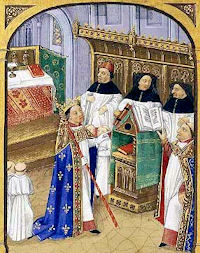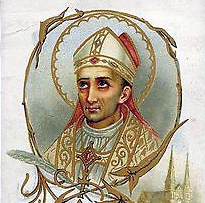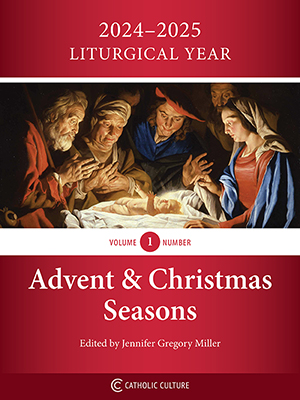Easter: April 10th
Thursday of the Third Week of Easter
Other Commemorations: St. Fulbert, Priest (RM)
» Enjoy our Liturgical Seasons series of e-books!
"Whoever believes in me believes not in me but in the one who sent me, and whoever sees me, sees the one who sent me. I, the light, have come into the world, so that whoever believes in me need not stay in the dark any more (Jn 12:44-46)." Jesus is soon to ascend to his Father. The glory and happiness of being instructed directly by the God-Man were for none but the Israelites, and even for them for only three short years. The apostles were called to preach the Gospel to every creature. Faith will spread throughout the world; the faithful shall be found in every land. And how did they come to the faith? By hearing, answers St. Paul. They heard the word, and they believed.
The Mystery That Sets You Aglow With God
Fire from Heaven — that was the sign of acceptation. You see it in the Old Testament again and again. Fire from Heaven fell on the offerings of Abraham, Gideon, David, and Solomon. Fire from Heaven was the sign in the New Testament as well; for it was the Uncreated Fire of Divinity that came down with Christ's soul to the Body of the Victim that lay in the tomb after it had been offered in the Cenacle and slain on Calvary. In the supper room we had the oblation. On the Hill of Skulls we had the mactation. The Fire that fell on the Body in the tomb not to consume, but to inflame with the light and life of glory, was the sure sign of acceptation. After that sign, we can fall down as did the people on Mt. Carmel that day of Elias' triumph, and cry as did they: "The Lord, He is God!"
This is the mystery that enables us to see that "the Lord, He is God" — and the Lord God of the living. It is He who has set you and me alive with His own life — and aglow with His own glory.
It is scriptural truth that we are radiant with the very radiance that shone from the Christ of Easter. Paul tells us that the Christ, whom he calls the last (or second) Adam, "became a spirit imparting life." He became that only after the Resurrection. The only life He had to impart then was the life he was then living — the life of glory. "Being alive now," says St. Paul, "should no longer mean living with your own life, but with his life, who died for us and is risen again" (2 Cor 5:15). . .
Easter saw the birth of a new race of men: Christians. We live in the Christian era, that epoch issued in by the Resurrection of Christ. It is the era of the "new man" one who lives with a "newness of life," and who, in all truth, is a "new creature." Easter ushered in that epoch in which men are to live with the life of the risen Christ. By His Resurrection Christ "made all things new." This newness of life for man is manifested by "newness of spirit" and "newness of mind," which brings about a newness in morals and mores. The Jews of old lived by the Law of Sinai - the Mosaic Law. The Gentiles of old lived by the law of their conscience — the Natural Law. Ultimately both laws derived from God, and both were good. But Christ gave us the New Law. Under it we live. It is the Law of Love!
Unquestionably, in our day and age, these are "hard sayings" — and who could believe them? But before you walk away, listen to St. Paul: "Christ died for us all, so that being alive should no longer mean living with your own life, but with his life who died and is risen again . . . henceforward we do not think of anyone in a merely human fashion . . . for . . . when a man becomes a new creature in Christ, his old life has disappeared, everything has become new about him . . . we entreat you, in Christ's name, make your peace with God. Christ never knew sin, and God made him into sin for us, so that in him we might be turned into the holiness of God" (2 Cor 5:15 sqq., Knox trans.).
Can you question the fact that you are alive with God after that testimony? St. Ambrose, Doctor of the Church, did not doubt it. He taught his people of Milan to believe it with all their beings by bringing them back to Moses and the Burning Bush. "So speaks Our Lord," said the Saint to his Milanese. "In this church I appear to you as I once appeared in the thornbush. You are the thornbush. I am the fire. I am the fire in the thornbush of your flesh. I am the fire to illuminate you, to burn away the thorns of your sinfulness, to give you the favor of my grace" (Epistola 63).
The mystery of Easter is the mystery of your present moment. You are aflame with the Fire who is God - the God who came out of the grave. You glow with His glory, for you are alive to God in Christ, and Christ is living within you. Or as Paul put it, you should put it: "for me, Christ is life" (Phil 1:21).
Excerpted from The Mysteries in Your Life by Rev. M. Raymond, O.C.S.O.
St. Fulbert
 Bishop, b. between 952 and 962; d. 10 April, 1028 or 1029. Mabillon and others think that he was born in Italy, probably at Rome; but Pfister, his latest biographer, designates as his birthplace the Diocese of Laudun in the present department of Gard in France. He was of humble parentage and received his education at the school of Reims, where he had as teacher the famous Gerbert who in 999 ascended the papal throne as Sylvester II. In 990 Fulbert opened a school at Chartres which soon became the most famous seat of learning in France and drew scholars not only from the remotest parts of France, but also from Italy, Germany, and England. Fulbert was also chancellor of the church of Chartres and treasurer of St. Hilary's at Poitiers. So highly was he esteemed as a teacher that his pupils were wont to style him "venerable Socrates". He was a strong opponent of the rationalistic tendencies which had infected some dialecticians of his times, and often warned his pupils against such as extol their dialectics above the teachings of the Church and the testimony of the Bible. Still it was one of Fulbert's pupils, Berengarius of Tours, who went farthest in subjecting faith to reason. In 1007 Fulbert succeeded the deceased Rudolph as Bishop of Chartres and was consecrated by his metropolitan, Archbishop Leutheric of Sens. He owed the episcopal dignity chiefly to the influence of King Robert of France, who had been his fellow student at Reims. As bishop he continued to teach in his school and also retained the treasurership of St. Hilary. When, about 1020, the cathedral of Chartres burned down, Fulbert at once began to rebuild it in greater splendour. In this undertaking he was financially assisted by King Canute of England, Duke William of Aquitaine, and other European sovereigns. Though Fulbert was neither abbot nor monk, as has been wrongly asserted by some historians, still he stood in friendly relation with Odilo of Cluny, Richard of St. Vannes, Abbo of Fleury, and other monastic celebrities of his times. He advocated a reform of the clergy, severely rebuked those bishops who spent much of their time in warlike expeditions, and inveighed against the practice of granting ecclesiastical benefices to laymen.
Bishop, b. between 952 and 962; d. 10 April, 1028 or 1029. Mabillon and others think that he was born in Italy, probably at Rome; but Pfister, his latest biographer, designates as his birthplace the Diocese of Laudun in the present department of Gard in France. He was of humble parentage and received his education at the school of Reims, where he had as teacher the famous Gerbert who in 999 ascended the papal throne as Sylvester II. In 990 Fulbert opened a school at Chartres which soon became the most famous seat of learning in France and drew scholars not only from the remotest parts of France, but also from Italy, Germany, and England. Fulbert was also chancellor of the church of Chartres and treasurer of St. Hilary's at Poitiers. So highly was he esteemed as a teacher that his pupils were wont to style him "venerable Socrates". He was a strong opponent of the rationalistic tendencies which had infected some dialecticians of his times, and often warned his pupils against such as extol their dialectics above the teachings of the Church and the testimony of the Bible. Still it was one of Fulbert's pupils, Berengarius of Tours, who went farthest in subjecting faith to reason. In 1007 Fulbert succeeded the deceased Rudolph as Bishop of Chartres and was consecrated by his metropolitan, Archbishop Leutheric of Sens. He owed the episcopal dignity chiefly to the influence of King Robert of France, who had been his fellow student at Reims. As bishop he continued to teach in his school and also retained the treasurership of St. Hilary. When, about 1020, the cathedral of Chartres burned down, Fulbert at once began to rebuild it in greater splendour. In this undertaking he was financially assisted by King Canute of England, Duke William of Aquitaine, and other European sovereigns. Though Fulbert was neither abbot nor monk, as has been wrongly asserted by some historians, still he stood in friendly relation with Odilo of Cluny, Richard of St. Vannes, Abbo of Fleury, and other monastic celebrities of his times. He advocated a reform of the clergy, severely rebuked those bishops who spent much of their time in warlike expeditions, and inveighed against the practice of granting ecclesiastical benefices to laymen.
Fulbert's literary productions include 140 epistles, 2 treatises, 27 hymns, and parts of the ecclesiastical Office. His epistles are of great historical value, especially on account of the light they throw on the liturgy and discipline of the Church in the eleventh century. His two treatises are in the form of homilies. The first has as its subject: Misit Herodes rex manus, ut affligeret quosdam de ecclesia, etc. (Acts 12:50); the second is entitled "Tractatus contra Judaeos" and proves that the prophecy of Jacob, "Non auferetur sceptrumde Juda", etc. (Genesis 49:10), had been fulfilled in Christ. Five of his nine extant sermons are on the blessed Virgin Mary towards whom he had a great devotion. The life of St. Aubert, bishop of Cambrai (d. 667), which is sometimes ascribed to Fulbert, was probably not written by him. Fulbert's epistles were first edited by Papire le Masson (Paris, 1585). His complete works were edited by Charles de Villiers (Paris, 1608), then inserted in "Bibl. magna Patrum" (Cologne, 1618) XI, in "Bibl. maxima Patri." (Lyons, 1677), XVIII, and with additions, in Migne, P.L., CXLI, 189-368.
—Excerpted from The Catholic Encyclopedia
Patronage: Chartres, France
Symbols and Representation: preaching monk; in his sick bed with the Virgin Mary nearby
Highlights and Things to Do:
- Find out more about St. Fulbert:






